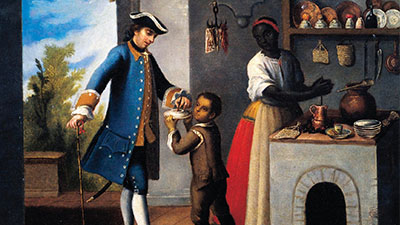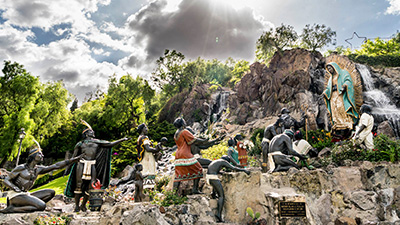Conquest
Teacher Resources
Driving Question: How did Europeans conquer empires in the Americas, and how did Indigenous people resist?
Beginning in the sixteenth century, Europeans invaded the Americas, imposing their rule on Indigenous communities. Disease, warfare, and slavery all took their toll on Indigenous American communities. Nonetheless, in every region, people resisted colonial rule.
Learning Objectives:
- Evaluate the strategies that European empires used to conquer and rule colonies in the Americas.
- Identify types of resistance and adaptation strategies employed by Indigenous Americans.
- Use sourcing skills to analyze how religions and cultures in the Americas changed as a result of colonization.
Vocab Terms:
- conquistador
- convert
- indigenous
- mestizo
- missionary
- syncretism
- viceroyalty
Opener: Conquest
To teach this lesson step, refer to page 2 of the Lesson 3.4 Teaching Guide.
European colonizers had powerful weapons and new strategies, but Indigenous communities responded with their own tools. How do you think they compared to each other?
Colonizing the Americas
To teach this lesson step, refer to page 3 of the Lesson 3.4 Teaching Guide.
Learn more about how OER Project approaches sourcing: Check out this short guide.
Want to know how other teachers used these sources? Read this conversation in the OER Project Teacher Community.
European empires established colonies from Canada to Brazil. The materials below provide a sense of the scale of colonization and delve deeper into one of the most infamous examples: the Spanish invasion of the Aztec Empire.
-
Guiding Questions
-
Before you read
Preview the questions below, and then skim the article. Be sure to look at the section headings and any images.
While you read
Look for answers to these questions:
- What two European powers were most important in early colonization of the Americas in the 1500s?
- What industries first developed in the Spanish colonies of New Spain and Peru?
- What methods did the King of Spain use to control the huge territory of New Spain?
- What were the two so-called “republics” in the Spanish colonies?
- What empires followed Spain and Portugal in the Americas, and in what ways did they differ?
After you read
Respond to this question: What methods of political, social, economic, and cultural control did Spain use in the territories of New Spain?
-
Guiding Questions
-
Before you read
Preview the questions below, and then skim the article. Be sure to look at the section headings and any images.
While you read
Look for answers to these questions:
- What were the differences between Spanish conquistadors and missionaries?
- What were some reasons the Spanish were so eager to get people to convert?
- What were some strategies used by the Spanish to try to convert the Indigenous population?
- What motivated some Aztecs to convert?
- How is the Lady of Guadalupe an example of religious syncretism?
After you read
Respond to this question: What are some ways that networks likely played a role in the conversion of Mesoamerican Indigenous communities?
Resistance
To teach this lesson step, refer to page 8 of the Lesson 3.4 Teaching Guide.
Check out the OER Project Video Guide for tips on using video in the classroom.
The Spanish colonization of the Americas happened quickly and spanned two continents. Consider some of the diverse methods that Indigenous people used to resist the invasions.
-
Guiding Questions
-
Before you watch
Preview the questions below, and then review the transcript.
While you watch
Look for answers to these questions:
- Why did the Spanish decide to invade New Mexico and what were some of the immediate consequences of the decision?
- What are some examples that Dr. Swentzell provides about how Pueblo people experienced colonization?
- What are some of the ways that Pueblo people resisted Spanish colonization before 1680?
- The Pueblo Revolt of 1680 was about many different issues, but it was sparked by one big event. What were the main grievances, and what was the big event?
- How did the Pueblos coordinate the revolt? Was it successful?
After you watch
Respond to these questions: The Pueblo Revolt of 1680 is sometimes called the first and most successful revolt against European colonialism. Do you agree? What evidence supports or refutes this claim?
Key Ideas
Closer: Conquest
To teach this lesson step, refer to page 10 of the Lesson 3.4 Teaching Guide.
Indigenous resistance against European rule in the Americas was widespread and constant. Evaluate how your thinking has changed over the course of this lesson.





